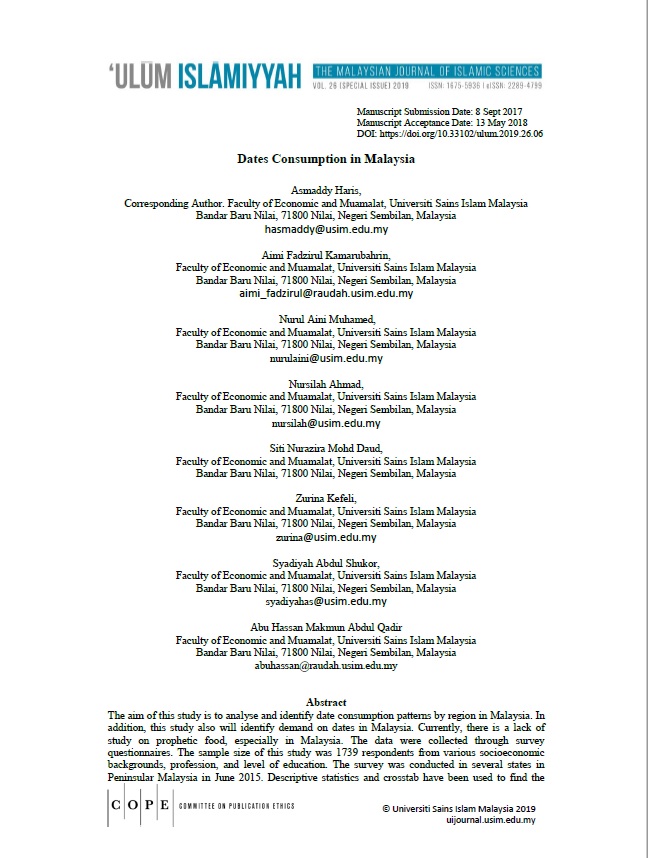Dates Consumption in Malaysia
DOI:
https://doi.org/10.33102/uij.vol26no.113Keywords:
dates, consumption, region, Malaysia, nutrition, food, IslamAbstract
The aim of this study is to analyse and identify date consumption patterns by region in Malaysia. In addition, this study also will identify demand on dates in Malaysia. Currently, there is a lack of study on prophetic food, especially in Malaysia. The data were collected through survey questionnaires. The sample size of this study was 1739 respondents from various socioeconomic backgrounds, profession, and level of education. The survey was conducted in several states in Peninsular Malaysia in June 2015. Descriptive statistics and crosstab have been used to find the results. The findings showed that Selangor had the most date consumers. The reason is that Selangor is an urban state, and the level of income of respondents from this state is higher compared to other states. Moreover, the level of education and awareness among respondents in Selangor are better compared to other states. This study also showed that people tend to consume dates not only because of religion but also because of health factors. Findings of the study can be used to formulate and develop a systematic supply chain in the dates market.
Downloads
References
Al-Shahib W and Marshall RJ. (2003). The fruit of the date palm: its possible use as the best food for the future? International Journal of Food Sciences and Nutrition. 2003; 54(4):247-259.
Baliga MS, Baliga BRV, Kandathil SM, Bhat HP and Vayalil PK. (2011). A review of the chemistry and pharmacology of the date fruits (Phoenix dactylifera L). Food Research International. 2011;44(7):1812-1822.
Baloch MK, Saleem SA, Ahmad K, Baloch AK, Baloch WA (2006). The impact of controlled atmosphere on the stability of Dhakki dates. Swiss Society of Food Science and Technology, 39: 671-676.
Brosekhan, A. and Velayutham, M. Consumer Buying Behaviour – A Literature Review: IOSR Journal of Business and Management (IOSR-JBM) e-ISSN: 2278-487X, p-ISSN: 2319-7668, PP 08-16.
Evans. L. M., Petty. R. E. and See. Y. H. M. (2009). The Impact of Perceived Message Complexity and Need for Cognition on Information Processing and Attitudes. Journal of Research in Personality. 43(5): pp. 880-889.
Foxall, G.R., Oliveira-Castro, J.M., James, V.K. and Schrezenmaier, T.C. (2011) 'Consumer behaviour analysis and the behavioural perspective model.', Management Online Review (MORE).
Fishbein, M., and Ajzen, I. (1975). Belief, Attitude, Intention, And Behaviour: An Introduction to Theory and Research. Reading, MA: Addison-Wesley.
Han, C. M. and Terpstra, V. (1988). Country-of-origin effects for uni-national and bi-national products. Journal of International Business Studies, 19, 235-255.
Hadith: Al-Bukhari. Vol. 7, Book 71, Hadith 663 (5445).
Hadith: Al-Bukhari. Vol. 7, Book 65, Hadith 359 (5448).
Kordi, M., Aghaei Meybodi, F., Tara, F., Nemati, M., Taghi Shakeri, M. (2014). The Effect of Late Pregnancy Consumption of Date Fruit on Cervical Ripening in Nulliparous Women. Journal of Midwifery and Reproductive Health, 2(3), 150-156. doi: 10.22038/jmrh.2014.2772
Loudon DL and Della Bitta AJ (1993). Consumer Behaviour: Concepts and Applications. (4th ed). McGraw Hill: Auckland.
Paul J. Peter, Jerry Corrie Olson (2008), Consumer Behaviour, McGraw-Hill/Irwin.
Quah S. H. and Tan. A. K. G. (2009). Consumer Purchase Decisions of Organic Products: An Ethnic Analysis. Journal of International Consumer Marketing. 22:1. pp. 47.
Research Optimus. (2018). What is Crosstab? Available [Online] at https://www.researchoptimus.com/article/cross-tab.php. (Accessed on 7 September 2018).
Vaezi S. (2004). Date is life tree. Tehran: Azineh Golmehr; 2004. [in persian]
Zohary, D. and M. Hopf. (2000). Domestication of Plants in the Old World (3rd Ed.), Oxford University Press, Oxford, UK.

Downloads
Published
How to Cite
Issue
Section
License
If the article is accepted for publication, the copyright of this article will be vested to author(s) and granted the journal right of first publication with the work simultaneously licensed under the Creative Commons Attribution-NonCommercial 4.0 International License, unless otherwise stated. Anyone may reproduce, distribute, translate and create derivative works of this article (for both commercial and non-commercial purposes), subject to full attribution to the original publication and authors. The full terms of this licence may be seen at https://creativecommons.org/licenses/by-nc/4.0/.






